Simple Soldering
A Beginners Guide to Jewelry Making

Kate Ferrant Richbourg

Contents





Sampler Square 1:
Connecting Metal Using Jump Rings
Sampler Square 2:
Texturing
Sampler Square 3:
Piercing & Sawing Lines in Metal
Sampler Square 4:
Riveting
Sampler Square 5:
Work-hardening, Annealing & Cleaning Fire Scale
Sampler Square 6:
Flowing Paste Solder
Sampler Square 7:
Flowing Wire Solder
Sampler Square 8:
Flowing Sheet Solder
Sampler Square 9:
One-Step Soldering
Sampler Square 10:
Sawing & Soldering a Cut Shape
Sampler Square 11:
Two-Step Soldering
Sampler Square 12:
Embellishing: Spiral, Dots & Granules
Sampler Square 13:
Forming Bails
Sampler Square 14:
Shaping & Soldering Domes
Sampler Square 15:
Making a Bezel & Setting a Stone
Sampler Square 16:
Making Two Small Bezels & Setting Stones


Welcome to the wonderful world of soldering and fabricating metal jewelry! If you are reading this book, you may currently be using beads as your main medium and are looking to take that next step into metalwork. Or perhaps you are just starting out in jewelry design. Sometimes as designers we just cant find prefabricated pieces that match the vision in our minds eye. Whats the solution? Make your own, of course!
Adding handcrafted metal elements to your jewelry allows you to start from the ground up and create pieces that are completely yours. Once you get the hang of forming, cutting, and soldering metal, the possibilities are nearly endless. Youll love the satisfaction that comes when someone exclaims about your beautiful jewelry and youre able to say, I made it!
I have learned from many years of teaching that people can be intimidated by that first step into the world of metalworking. Because heat (coming from a butane torch) is used, theres a common misunderstanding that crafting with metal requires a large setup and heavy-duty tools.
But take a deep breath: Its not as expensive or dangerous as it seems. A few simple tools, a guide to proper technique, and common sense are all you need. Anyone can do this, and I will show you how!
I have taught thousands of people how to successfully wield a torch and make metal jewelry. During that time, I have encountered just about every mistake a person can make, and made some of them myself. In this guide, I will lead you through the steps to do it the right way and how you how to analyze and fix anything that doesnt turn out as well as you had hoped. All you need to start is a little confidence and good sense, and you will be sawing, soldering, and forming in no time. I will be there to cheer you on in your success and coach you through the tough parts.
It may take you a little time and concentration, but the rewards are great! You can do this, and I am here to help. Lets get started!

This book is going to act as your guide, teacher, and troubleshooter to help you understand the fundamentals of metalworking. It is designed to build a foundation of solid techniques and classic designs that you can use as a springboard to create your own pieces and give your work a personal touch.
We start with an overview of what soldering is, how it works, and why. Then I will discuss the tools and materials that are used in the projects in this book. After that, you are going to hone your skills in a unique sampler section, in which you will create sixteen 1" (2.5 cm) square pieces of copper featuring every technique used to make the projects later in the book. This sampler section represents the heart and soul of my teaching method and will allow you to learn at your own pace and focus on the process rather than the result. One of the biggest barriers that I encounter in my classes is the fear students have of messing up. By learning techniques on the sampler you can feel free to make mistakesand learn how to correct them. By the time that you complete the sampler, your skills will be perfected.
After working on the sampler section you will be able to move on to making projects. By then you can make use of all the techniques you have learned with the confidence of an expert. Where you go from there is up to you. You might entertain the thought of jumping into your own designs or coming up with creative variations on what youve learned. Wouldnt that be exciting?
WORKING YOUR WAY THROUGH THE SAMPLER & PROJECTS
It is important to make your sampler before jumping into the projects. The sampler builds important skills!
Also, note that the projects are presented in order from easiest to most difficult. Before you tackle any project, please read the instructions all the way through. If necessary, refer back to the samplers referenced in order to brush up on the techniques involved.
ICON KEY

tip
Through my years of experience making jewelry, I have learned a lot of tricks through trial and error. These helpful tips are marked with the icon above.

meet a new tool
Certain projects require more specialized or advanced tools. I will introduce these as they are needed throughout the book with the icon above.

Throughout this book, I will be using many terms unique to metal jewelry crafting. For this reason, I have included this chapter to give you a basic understanding of the language of the craft, as well as how soldering actually works and how the types and grades of solder affect the process. Although I highly recommend that you read this chapter first, dont be nervous if you have a few questions. All these subjects will be discussed in more depth throughout the book, but the basic concepts in this chapter will stand you in good stead for what is to come. Think of it as Soldering 101.
The solder in this book is silver solder, which is an alloy of silver and other metals (see Metals 101 below). It is appropriate for the variety of metals used in this book. When placed on a metal surface and heated, solder will melt or flow. As it does so, it will bind to any metal around it, provided that the metal is clean and the join is flush (completely touching). For this reason, throughout the book I have put many reminders about cleaning and filing your piece before soldering. As the solder cools, if it is touching two such surfaces, it will form a solid and sturdy metal bond, or join, between them.

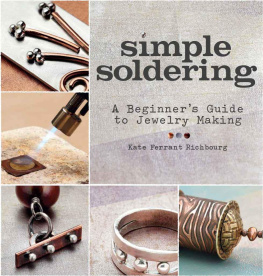


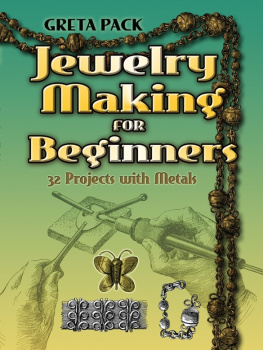
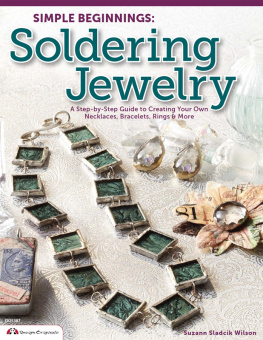
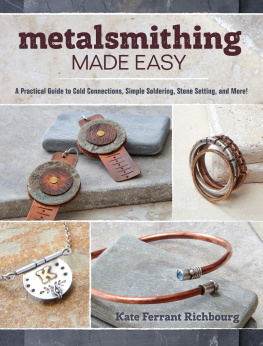
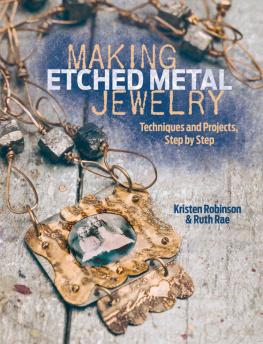
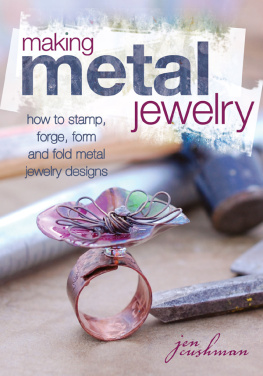










 tip
tip meet a new tool
meet a new tool